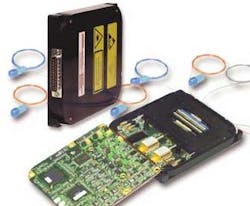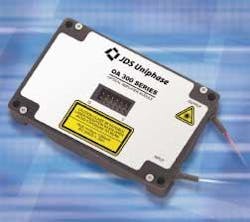EDFA manufacturers look to the metro
When asked to comment on the level of activity in the optical-amplifier space, one industry insider paused, then replied, "Well, I could say, 'There's not much,' and we could both hang up and that would be a very good overview of the market." Today's carriers are spending only where they must and when they must—mostly on line-card upgrades—leaving infrastructure boxes like multiplexers and amplifiers collecting dust on warehouse shelves. Given the abysmal state of the long-haul (LH) and ultra-long-haul (ULH) markets, the metro segment seems to hold the most promise for erbium-doped fiber-amplifier (EDFA) manufacturers—and even then deployment is likely to be modest for quite some time.
"Any prospect at all of [WDM] being the mainstream way of doing metro networking may have been pushed off by a decade," contends Lawrence Gasman, president and director of optical-component research at Communications Industry Researchers (CIR—Charlottesville, VA). In the near-term, bandwidth needs in the metro may be met using next-generation SONET boxes, which don't require amplification.
That said, when complex WDM metro networks do emerge, amplification should play a critical role. LH amplifiers are traditionally used to compensate for losses in the fiber over the distance of the link, and the same need should emerge in the metro where a core ring might span several hundred kilometers. There is also a need to compensate for component loss in metro networks, since every add/drop multiplexer, filter, or switch device incurs a loss.
Moreover, says Peter Grittner, director of product management for Corning's (Corning, NY) amplifier line, channels are constantly added and dropped in the metro environment. "All of a sudden, the gain or strength of the through traffic might have a different power level than the channels being added or dropped. Amplification is a very economic, efficient means to compensate or equalize these different power levels," explains Grittner.
Of course, such discussion will be moot if EDFAs don't hit the necessary price points required for metro deployment. Today, the industry is seeing the most price pressure on simple narrowband gain blocks—just the passive optics, erbium fiber, and pump laser without the associated electronics, asserts Lesley LemMon, product-line manager for optical amplifiers at JDS Uniphase (Ottawa, Ontario, and San Jose, CA). A few years ago, a gain block was a $3,000-$5,000 product. About one year ago at OFC 2002, several companies introduced gain blocks in the $2,000-$3,000 range. The goal is to make them even less expensive—but how?
One way to reduce costs is to reduce footprint size, and an increased use of microcomponents has resulted in a new breed of ultra-compact gain blocks. One such component is the 980-nm uncooled pump laser, which eliminates the need for a thermo-electric cooler. The cooler accounts for roughly two-thirds of the power consumption of the optical port. Today's uncooled pump lasers provide 250 mW of power, but future incarnations may provide as much as 500 mW.The use of coolerless pumps will reduce amplifier size significantly, which is "going to change a lot of thinking," says LemMon. "I can go to my customer and say, 'I can give you twice the functionality and half the size; what does this do for you as a system designer?' As these products go out in the market, you're really going to see a shift in how people think about designing a system, because the standard accepted practices for what's available will start to change."
Metro EDFAs do not have to be as stringent in terms of noise figure and ripple as their LH and ULH cousins, but metro networks demand a much faster transient response. "When you change the channel compositions at the input of the amplifier, the characteristics of the amplifier may change—mainly the flatness of the amplifier changes," explains Gerald Chretien, director of product strategy at Alcatel Optronics (Paris). Many vendors, Alcatel included, are integrating variable optical attenuators (VOAs) into their amplifier designs to deliver a faster transient response. "The VOA enables us to guarantee the flatness of the amplifier over a wider dynamic range," says Chretien. "It used to be a few decibels-1 or 2 dB, but not more. Now we can have the flatness over more than a 10-dB dynamic range with just a VOA."
"System houses look to us now to deliver an electronically controlled amplifier, which is different from the traditional requests coming out of the LH area," adds Grittner. "The requirement for us as an amplifier or EDFA supplier is to provide an amplifier with midstage access that is able to deliver a good transient performance, which includes good controls. In that respect, amplifiers have become smarter."
In the future, EDFAs may integrate sophisticated dynamic gain equalizers with the appropriate monitoring schemes at the input and output of the amplifier to more precisely adjust the flatness in different conditions.
Some system designers are beginning to contemplate the use of amplifiers in the access environment as well. Both metro and access networks are dense in terms of the number of nodes, providing ample opportunity for signal loss. But with the metro WDM market so far from maturity, is it too early to think about WDM in the access?"Whether those markets really needed amplifiers or not is unclear at this point," admits Gasman. "What is clear is that if you are going to start moving into the low end, you really need to get the prices down for amplifiers. And that's probably only going to happen by deploying some kind of integration technology."
A number of companies are looking at semiconductor optical amplifiers (SOAs) and erbium-doped waveguide amplifiers (EDWAs) to provide the necessary integration. While he believes both technologies might represent the next leap forward, Gasman says that neither SOAs nor EDWAs are quite ready for prime time yet.
"Now is not a time when people are asking for new, cutting-edge technologies," agrees JDS Uniphase's LemMon. "They want reliable, low-cost, well-performing products."


